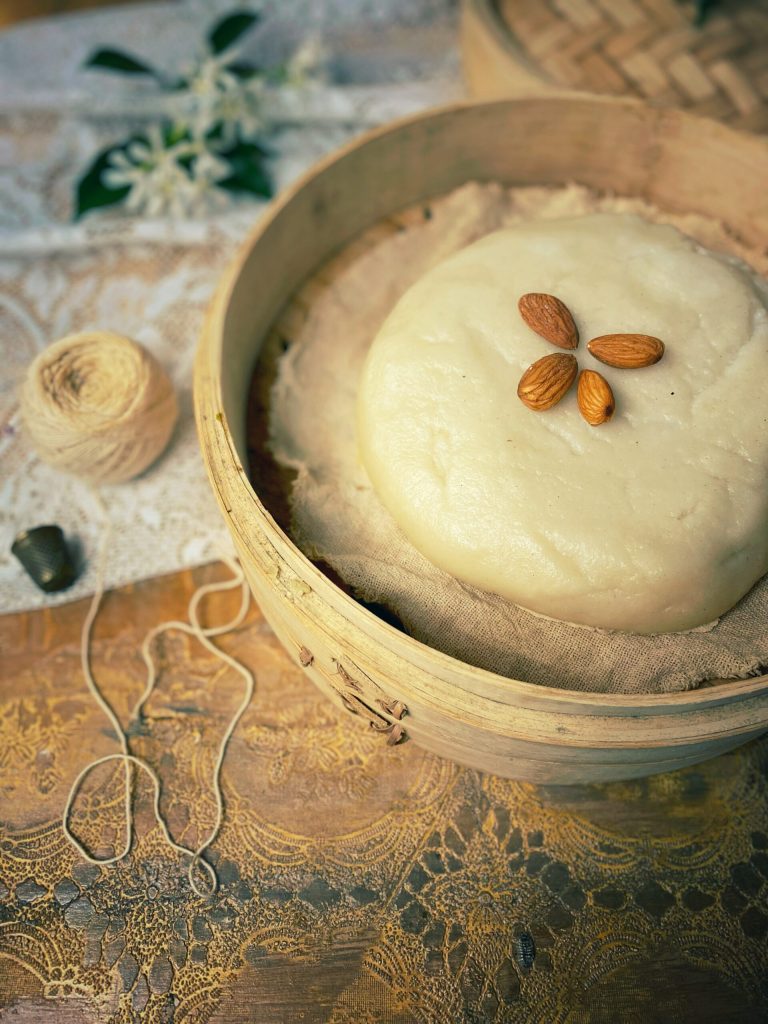The Baekseolgi 백설기 is one of the dishes present at the doljanchi, along with susupatteok, injeolmi, and songpyeon.
It is a kind of rice cake (tteok) made with glutinous rice flour paste, very important in Korean culture, and consumed on special occasions, like a child’s hundredth day after birth.
The term baekseolgi derives from the Chinese characters baek (白), which means both “white” and “hundred”, and sol (雪), which means “snow”, and gi (只), “rice cake”: its purpose was to both recall the color of snow and wish the child a long life of a hundred years.
The doljanchi is a Korean tradition to celebrate a child’s first birthday, wishing them a prosperous future.
The tradition originated during the Joseon dynasty, a period when infant mortality rates within a year of birth were very high.
For this reason, surpassing the first year of life was an important milestone worthy of a grand celebration.
According to tradition, on the morning of the birthday, the family gathers in front of the samsinsang, a table set for the deities of pregnancy and childbirth (Samsin halmeoni), and gives thanks by serving rice, miyeokguk, and tteok.
The real party begins with the arrival of relatives and friends and culminates with the doljabi, where the celebrant is encouraged to choose one of the objects placed on the table: paper, brush, book, and ink for a male; scissors, knife, spoon, clothes, measuring tape, thread, and needle for a female.
Based on the chosen object, the future of the celebrant is predicted.
For most Korean families, this celebration is one of the most important family events as it is believed to be closely linked to the health and happiness of their young family member.

Ingredients
- 14 oz glutinous rice flour
- 1 cup water
- 2 oz sugar
- 1 teaspoon salt
- 4 almonds (or other nuts – optional)
Steps
Mix the flour with water. Add sugar and a pinch of salt.
Mix with your hands.
Create a sort of round cake, using a cutter, place in the steamer, cover with a cloth, smooth the surface, and steam for 25 minutes.
You can decorate with almonds or other nuts.
I used the Magic Cooker lid, placing the cake in the pan, adding a glass of water, and cooking covered over high heat for the first 2 minutes and low heat for the next 20 minutes.

You can buy the Magic Cooker lid
FAQ
How does the doljanchi ceremony take place?
The ceremony of doljanchi begins with the banquet, called dolsang in Korean, dedicated to the deity Samsin halmeoni, considered the patron of children.
The child is seated in the center, dressed in the hanbok, and the food arrayed in front of them consists of a variety of tteok (rice cakes): baekseolgi, susupatteok (rice dumplings made with red beans that were considered to have apotropaic value due to their reddish color), injeolmi (glutinous rice dumpling, steamed and kneaded until a sticky consistency is achieved), and songpyeon (dumplings, some filled, that wish the child a fruitful growth, both in character and physical constitution).
And noodles, which, due to their long and thin shape, symbolize longevity.
On the table, there can also be fruit that symbolizes prosperity.
Rice is considered a very important food in Korean cuisine, also due to its scarcity in the past.
The term doljabi comes from the Korean dol (돌?), which means the “first birthday of the child”, jab (잡?), which means “grab”, and i (이?), the subject particle.
The real party begins with the arrival of relatives and friends and culminates with the doljabi.
The doljabi is the ritual of grabbing an object placed on the table.
This custom is traced back to ancient China; in Korea, it began to spread widely during the Joseon period, initially among the royal family members and, over time, among common people’s families.
Depending on the child’s gender, objects such as paper, brush, book, and ink for a male; scissors, knife, spoon, clothes, tape measure, thread and needle for a female were placed on the table.
Based on what the child grabbed, their future could be predicted.
For example, if the child grabbed the paper or the brush, it was thought they would become a scholar; if the girl grabbed the scissors or needle, she would become a good wife and homemaker.
Nowadays, it is still a practiced custom, but other more modern objects have been added, such as the stethoscope, the basketball or the microphone.

